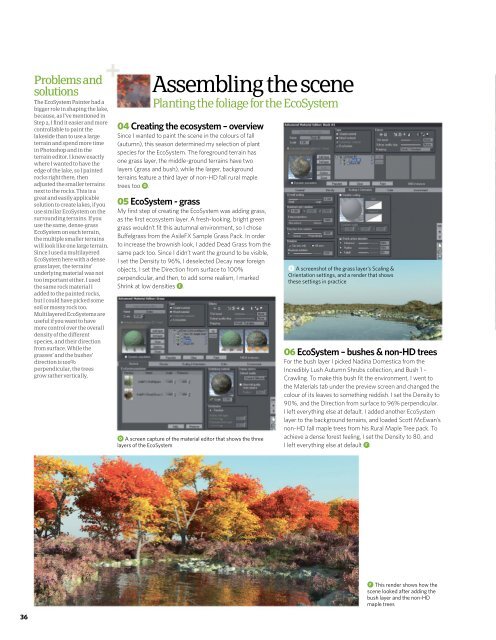Create successful ePaper yourself
Turn your PDF publications into a flip-book with our unique Google optimized e-Paper software.
Problems and<br />
solutions<br />
The EcoSystem Painter had a<br />
bigger role in shaping the lake,<br />
because, as I’ve mentioned in<br />
Step 2, I find it easier and more<br />
controllable to paint the<br />
lakeside than to use a large<br />
terrain and spend more time<br />
in Photoshop and in the<br />
terrain editor. I knew exactly<br />
where I wanted to have the<br />
edge of the lake, so I painted<br />
rocks right there, then<br />
adjusted the smaller terrains<br />
next to the rocks. This is a<br />
great and easily applicable<br />
solution to create lakes, if you<br />
use similar EcoSystem on the<br />
surrounding terrains. If you<br />
use the same, dense-grass<br />
EcoSystem on each terrain,<br />
the multiple smaller terrains<br />
will look like one large terrain.<br />
Since I used a multilayered<br />
EcoSystem here with a dense<br />
grass layer, the terrains’<br />
underlying material was not<br />
too important either. I used<br />
the same rock material I<br />
added to the painted rocks,<br />
but I could have picked some<br />
soil or mossy rock too.<br />
Multilayered EcoSystems are<br />
useful if you want to have<br />
more control over the overall<br />
density of the different<br />
species, and their direction<br />
from surface. While the<br />
grasses’ and the bushes’<br />
direction is 100%<br />
perpendicular, the trees<br />
grow rather vertically.<br />
Assembling the scene<br />
Planting the foliage for the EcoSystem<br />
04 Creating the ecosystem – overview<br />
Since I wanted to paint the scene in the colours of fall<br />
(autumn), this season determined my selection of plant<br />
species for the EcoSystem. The foreground terrain has<br />
one grass layer, the middle-ground terrains have two<br />
layers (grass and bush), while the larger, background<br />
terrains feature a third layer of non-HD fall rural maple<br />
trees too d.<br />
05 EcoSystem - grass<br />
My first step of creating the EcoSystem was adding grass,<br />
as the first ecosystem layer. A fresh-looking, bright green<br />
grass wouldn’t fit this autumnal environment, so I chose<br />
Buffelgrass from the AsileFX Sample Grass Pack. In order<br />
to increase the brownish look, I added Dead Grass from the<br />
same pack too. Since I didn’t want the ground to be visible,<br />
I set the Density to 96%, I deselected Decay near foreign<br />
objects, I set the Direction from surface to 100%<br />
perpendicular, and then, to add some realism, I marked<br />
Shrink at low densities e.<br />
D A screen capture of the material editor that shows the three<br />
layers of the EcoSystem<br />
E A screenshot of the grass layer’s Scaling &<br />
Orientation settings, and a render that shows<br />
these settings in practice<br />
06 EcoSystem – bushes & non-HD trees<br />
For the bush layer I picked Nadina Domestica from the<br />
Incredibly Lush Autumn Shrubs collection, and Bush 1 –<br />
Crawling. To make this bush fit the environment, I went to<br />
the Materials tab under the preview screen and changed the<br />
colour of its leaves to something reddish. I set the Density to<br />
90%, and the Direction from surface to 96% perpendicular.<br />
I left everything else at default. I added another EcoSystem<br />
layer to the background terrains, and loaded Scott McEwan’s<br />
non-HD fall maple trees from his Rural Maple Tree pack. To<br />
achieve a dense forest feeling, I set the Density to 80, and<br />
I left everything else at default F.<br />
F This render shows how the<br />
scene looked after adding the<br />
bush layer and the non-HD<br />
maple trees<br />
36


